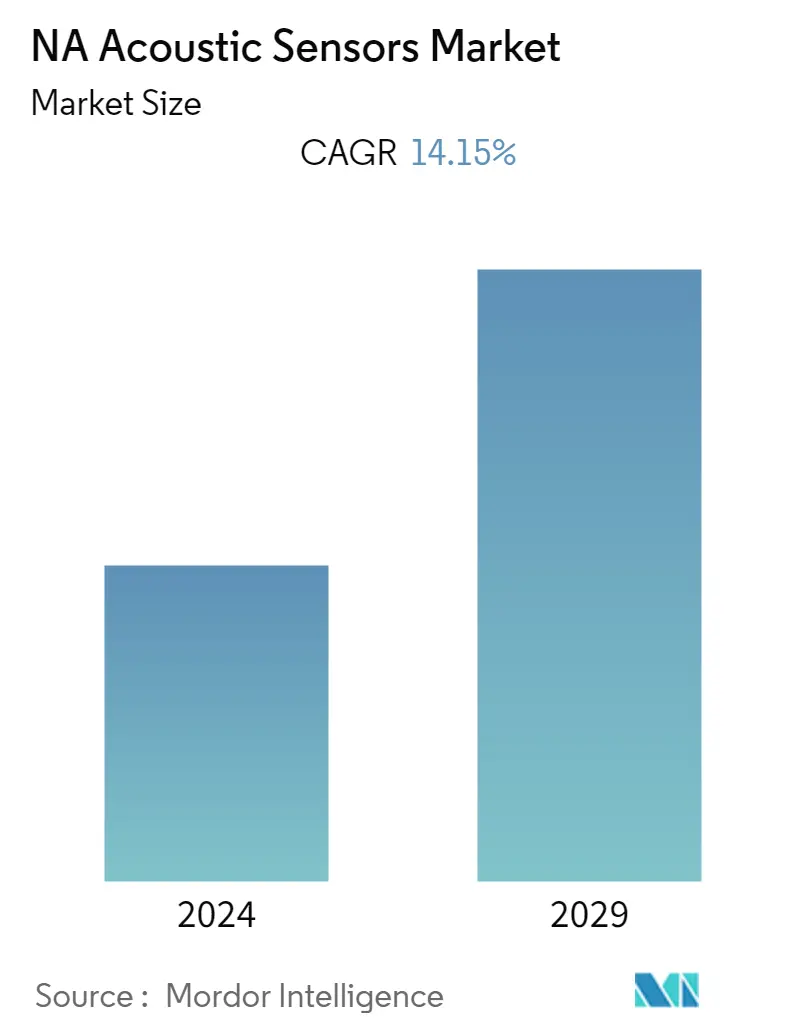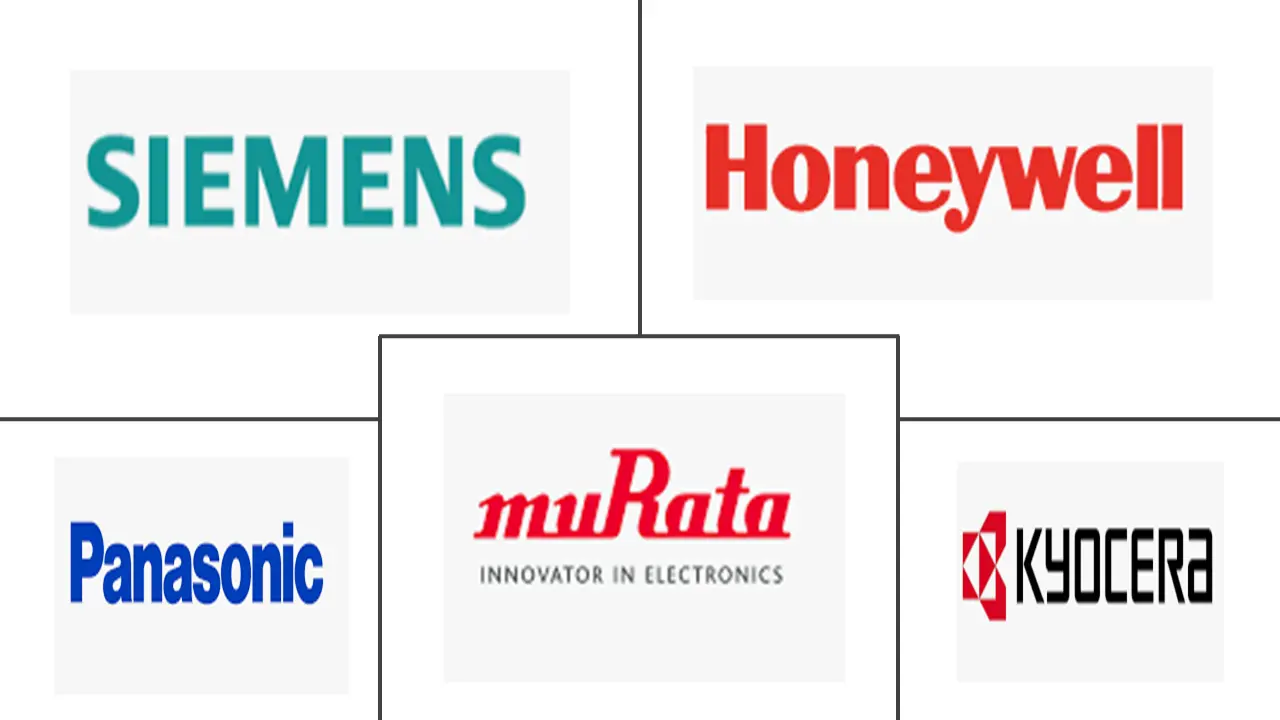Market Size of NA Acoustic Sensors Industry

| Study Period | 2019 - 2029 |
| Base Year For Estimation | 2023 |
| Forecast Data Period | 2024 - 2029 |
| Historical Data Period | 2019 - 2022 |
| CAGR | 14.15 % |
| Market Concentration | Low |
Major Players
*Disclaimer: Major Players sorted in no particular order |
North America Acoustic Sensors Market Analysis
The North America Acoustic Sensors market was is expected to grow at a CAGR of 14.15% over the forecast period (2022 - 2027). The use of acoustic sensors for acoustic-wave-based MEMS devices has created a promising technology platform available for a wide range of applications. These devices have high sensitivity and can operate wirelessly.
- Due to its use in television transmitters and radios to create signals for transmission, the surface wave acoustic sensor is predicted to rise rapidly throughout the forecast period. SAW devices are needed as filters in radio frequency applications and are critical components in satellite communication terminals and base stations.
- Furthermore, acoustic sensors have lately seen a surge in demand in automotive applications. The complete quiet of electric automobile motors may be a danger to unwary pedestrians. As a result, all new electric and hybrid cars will require auditory warning systems. As a result, increased worries about traffic management will propel the market forward.
- By merging silicon-based microelectronics with micromachining technology, MEMS has been designated as one of the most promising technologies of the twenty-first century, having the potential to change both industrial and consumer products. Because of their great sensitivity and ability to work wirelessly, new acoustic-wave-based MEMS devices provide a potential technology platform for a wide range of applications.
- The examined market experienced supply chain disruption during the first phase of the COVID-19 due to statewide lockdown and shutdown of several production facilities. However, from the second quarter of 2020, the market began to experience a resurgence in demand and output, mirroring the semiconductor industry trend.
North America Acoustic Sensors Industry Segmentation
Acoustic wave sensors are a division of micro-electromechanical systems that work on the theory of modulating surface acoustic waves which sense the physical phenomenon. They are used to convert electrical signals into mechanical waves. They are used in various fields such as signal processing, sensing, and others. The study characterizes the market based on type, wave type, sensing parameter, application, and country. The study also covers the impact of COVID-19 on the Industry.
| By Type | |
| Wired | |
| Wireless |
| By Wave Type | |
| Surface Wave | |
| Bulk Wave |
| By Sensing Parameter | |
| Temperature | |
| Pressure | |
| Torque |
| By Application | |
| Aerospace and Defense | |
| Automotive | |
| Consumer Electronics | |
| Healthcare | |
| IT and Telecom | |
| Others |
| By Country | |
| United States | |
| Canada |
NA Acoustic Sensors Market Size Summary
The North America Acoustic Sensors market is poised for significant growth, driven by the increasing integration of acoustic sensors in various applications. These sensors, particularly those based on acoustic-wave MEMS technology, offer high sensitivity and wireless operation, making them suitable for a wide range of uses. The telecommunications sector stands out as the largest consumer, with the demand for acoustic sensors fueled by the proliferation of smartphones and base stations. The need for efficient communication systems, especially with the rollout of 5G technology, has led to a surge in the use of Surface Acoustic Wave (SAW) devices, which are essential for filtering radio frequencies in mobile devices. Additionally, the automotive industry is witnessing a rise in demand for acoustic sensors due to the necessity of auditory warning systems in electric and hybrid vehicles, addressing safety concerns for pedestrians.
The market landscape is characterized by a fragmented structure with numerous global and local manufacturers, including major players like Honeywell, Siemens AG, and Panasonic. These companies are actively pursuing strategic partnerships, acquisitions, and innovations to expand their market presence. Recent developments highlight the ongoing advancements in acoustic sensor technology, such as American Robotics' use of acoustics-based systems for drone operations and Bosch Sensortec's precision pressure sensors. The market's growth trajectory is further supported by the increasing adoption of acoustic sensors in consumer electronics and industrial applications, underscoring their versatility and importance in modern technology.
NA Acoustic Sensors Market Size - Table of Contents
-
1. MARKET INSIGHTS
-
1.1 Market Overview
-
1.2 Value Chain / Supply Chain Analysis
-
1.3 Industry Attractiveness - Porter's Five Forces Analysis
-
1.3.1 Threat of New Entrants
-
1.3.2 Bargaining Power of Buyers
-
1.3.3 Bargaining Power of Suppliers
-
1.3.4 Threat of Substitute Products
-
1.3.5 Intensity of Competitive Rivalry
-
-
1.4 Assessment of COVID-19 Impact on the Industry
-
-
2. MARKET SEGMENTATION
-
2.1 By Type
-
2.1.1 Wired
-
2.1.2 Wireless
-
-
2.2 By Wave Type
-
2.2.1 Surface Wave
-
2.2.2 Bulk Wave
-
-
2.3 By Sensing Parameter
-
2.3.1 Temperature
-
2.3.2 Pressure
-
2.3.3 Torque
-
-
2.4 By Application
-
2.4.1 Aerospace and Defense
-
2.4.2 Automotive
-
2.4.3 Consumer Electronics
-
2.4.4 Healthcare
-
2.4.5 IT and Telecom
-
2.4.6 Others
-
-
2.5 By Country
-
2.5.1 United States
-
2.5.2 Canada
-
-
NA Acoustic Sensors Market Size FAQs
What is the current NA Acoustic Sensors Market size?
The NA Acoustic Sensors Market is projected to register a CAGR of 14.15% during the forecast period (2024-2029)
Who are the key players in NA Acoustic Sensors Market?
Siemens AG, Honeywell International Inc., Murata Manufacturing Co., Ltd., Panasonic Corporation and KYOCERA Corporation are the major companies operating in the NA Acoustic Sensors Market.

